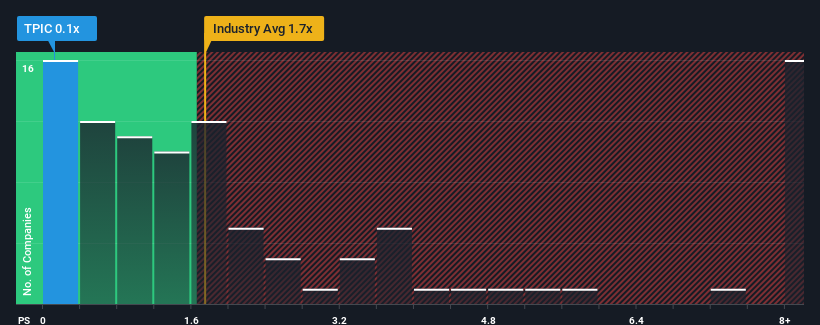- United States
- /
- Electrical
- /
- NasdaqGM:TPIC
Improved Revenues Required Before TPI Composites, Inc. (NASDAQ:TPIC) Stock's 33% Jump Looks Justified

The TPI Composites, Inc. (NASDAQ:TPIC) share price has done very well over the last month, posting an excellent gain of 33%. Still, the 30-day jump doesn't change the fact that longer term shareholders have seen their stock decimated by the 60% share price drop in the last twelve months.
In spite of the firm bounce in price, TPI Composites may still be sending bullish signals at the moment with its price-to-sales (or "P/S") ratio of 0.1x, since almost half of all companies in the Electrical industry in the United States have P/S ratios greater than 1.7x and even P/S higher than 4x are not unusual. However, the P/S might be low for a reason and it requires further investigation to determine if it's justified.
Check out our latest analysis for TPI Composites

What Does TPI Composites' P/S Mean For Shareholders?
TPI Composites could be doing better as its revenue has been going backwards lately while most other companies have been seeing positive revenue growth. Perhaps the P/S remains low as investors think the prospects of strong revenue growth aren't on the horizon. So while you could say the stock is cheap, investors will be looking for improvement before they see it as good value.
Want the full picture on analyst estimates for the company? Then our free report on TPI Composites will help you uncover what's on the horizon.Do Revenue Forecasts Match The Low P/S Ratio?
TPI Composites' P/S ratio would be typical for a company that's only expected to deliver limited growth, and importantly, perform worse than the industry.
Retrospectively, the last year delivered a frustrating 4.4% decrease to the company's top line. This has soured the latest three-year period, which nevertheless managed to deliver a decent 27% overall rise in revenue. So we can start by confirming that the company has generally done a good job of growing revenue over that time, even though it had some hiccups along the way.
Turning to the outlook, the next three years should generate growth of 6.6% each year as estimated by the analysts watching the company. Meanwhile, the rest of the industry is forecast to expand by 36% per year, which is noticeably more attractive.
With this information, we can see why TPI Composites is trading at a P/S lower than the industry. Apparently many shareholders weren't comfortable holding on while the company is potentially eyeing a less prosperous future.
The Key Takeaway
TPI Composites' stock price has surged recently, but its but its P/S still remains modest. We'd say the price-to-sales ratio's power isn't primarily as a valuation instrument but rather to gauge current investor sentiment and future expectations.
We've established that TPI Composites maintains its low P/S on the weakness of its forecast growth being lower than the wider industry, as expected. Right now shareholders are accepting the low P/S as they concede future revenue probably won't provide any pleasant surprises. Unless these conditions improve, they will continue to form a barrier for the share price around these levels.
Before you settle on your opinion, we've discovered 3 warning signs for TPI Composites (1 is potentially serious!) that you should be aware of.
If you're unsure about the strength of TPI Composites' business, why not explore our interactive list of stocks with solid business fundamentals for some other companies you may have missed.
Valuation is complex, but we're here to simplify it.
Discover if TPI Composites might be undervalued or overvalued with our detailed analysis, featuring fair value estimates, potential risks, dividends, insider trades, and its financial condition.
Access Free AnalysisHave feedback on this article? Concerned about the content? Get in touch with us directly. Alternatively, email editorial-team (at) simplywallst.com.
This article by Simply Wall St is general in nature. We provide commentary based on historical data and analyst forecasts only using an unbiased methodology and our articles are not intended to be financial advice. It does not constitute a recommendation to buy or sell any stock, and does not take account of your objectives, or your financial situation. We aim to bring you long-term focused analysis driven by fundamental data. Note that our analysis may not factor in the latest price-sensitive company announcements or qualitative material. Simply Wall St has no position in any stocks mentioned.
About NasdaqGM:TPIC
TPI Composites
Manufactures and sells composite wind blades, and related precision molding and assembly systems to original equipment manufacturers (OEMs) in the United States, Mexico, Europe, the Middle East, Africa, and India.
Undervalued with moderate growth potential.
Market Insights
Community Narratives



